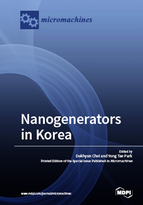Nanogenerators in Korea
A special issue of Micromachines (ISSN 2072-666X). This special issue belongs to the section "A:Physics".
Deadline for manuscript submissions: closed (30 October 2018) | Viewed by 64580
Special Issue Editors
Interests: nano sensors; nanoenergy; electronic skin with physical sensor; plasmonics; nanostructures; nanocomposites; piezoelectronics; energy harvesting; triboelectric; atomic force microscopy; tip-enhanced Raman spectroscopy; physical sensor; flexible device; stretchable device; nanomechanics; meta-materials
Special Issues, Collections and Topics in MDPI journals
Special Issue Information
Dear Colleagues,
Fossil fuels leaded the 21st century industrial revolution but caused some critical problems such as exhaustion of resources and global warming. Also, current power plants require too much high cost and long time for establishment and facilities to provide electricity. Thus, developing new power production systems with environmental friendliness and low-cost is critical global needs. There are some emerging energy harvesting technologies such as thermoelectric, piezoelectric, and triboelectric nanogenerators, which have great advantages on eco-friendly low-cost materials, simple fabrication, and various operating sources. Since the introduction of various energy harvesting technologies, many novel designs and applications as power suppliers and physical sensors in the world have been demonstrated based on their unique advantages. In this Special Issue, we would like to address and share basic approaches, new designs, and industrial applications related to thermoelectric, piezoelectric, and triboelectric devices which are on-going in Korea. With this Special Issue, we aim to promote fundamental understanding and to find novel ways to achieve industrial product manufacturing for energy harvesters.
Dr. Dukhyun Choi
Dr. Yong Tae Park
Guest Editors
Manuscript Submission Information
Manuscripts should be submitted online at www.mdpi.com by registering and logging in to this website. Once you are registered, click here to go to the submission form. Manuscripts can be submitted until the deadline. All submissions that pass pre-check are peer-reviewed. Accepted papers will be published continuously in the journal (as soon as accepted) and will be listed together on the special issue website. Research articles, review articles as well as short communications are invited. For planned papers, a title and short abstract (about 100 words) can be sent to the Editorial Office for announcement on this website.
Submitted manuscripts should not have been published previously, nor be under consideration for publication elsewhere (except conference proceedings papers). All manuscripts are thoroughly refereed through a single-blind peer-review process. A guide for authors and other relevant information for submission of manuscripts is available on the Instructions for Authors page. Micromachines is an international peer-reviewed open access monthly journal published by MDPI.
Please visit the Instructions for Authors page before submitting a manuscript. The Article Processing Charge (APC) for publication in this open access journal is 2600 CHF (Swiss Francs). Submitted papers should be well formatted and use good English. Authors may use MDPI's English editing service prior to publication or during author revisions.
Keywords
- Mechanical energy harvesters
- Piezoelectric and triboelectric nanogenerators
- Thermoelectricity
- hybrid energy scavengers
- Energy transfer
- Self-powered sensors
- Self-powered wearable electronics








